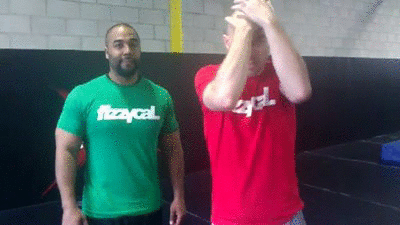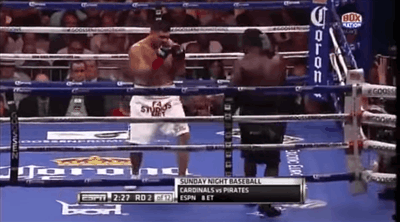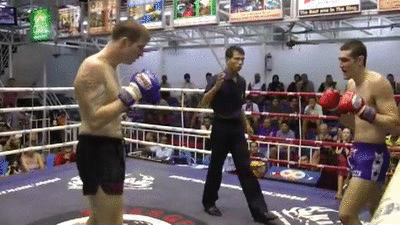
So a young man that wants to fight that I try to help fill in gaps in his knowledge came to me with a question.
He said to me that he is afraid to attack in striking and sticks to countering, because he’s afraid of being countered himself.
Now I find this a problem, because while I have always advocated working on defense, you’re defense exists so you can have an attack mindset, so you never have to worry about not getting hit because it’s automatic, because your focus should be on attacking or advancing.
So I grab the fucker and I basically did a drill that doesn’t seem to have a name, but advanced strikers seem to do it all the time. I basically had him attack me, then when I countered or interrupted him, he would shut it down or counter himself.
The lesson being is that to be able to attack without fear means you have to be able to turn you’re opponents counter attacks into opportunities. I found when I attack, I can turn most counters to my head into more opportunity. Other responses broke my flow. But that’s not the topic of this post is it?
What did this drill teach me about covers and blocks as a form of defense?
Well I’ll try to make this post short.
Essentially when I used a cover or block to deal with an incoming counter, continuing the attack was hard. It would create a stop in the cadence of the fight, which gives the opponent another chance to counter. They have something on you to read, to work off of.
Meanwhile slipping and rolling allowed an attack to continue before they could re-counter.

The cover simply did not offer this.
Parrying(Depending on how it’s done) can also continue the momentum of aggression, or atleast continue to flow from one action to another without much interruption.


The top image shows parrying without initiating an attack, but the bottom shows using the palm/parry to lead an opponent off balance and attack, there is no alerting them. Not only that, but parrying easily works with hand fighting from boxing and Muay thai, it’s by it’s nature both defensive and offensive, for a parry quickly becomes a hand trap and control.
Covering however is the most ‘purely defensive’ motion out there, it doesn’t lead into an attack.

Notice how the moment he starts throwing, his opponent is no where close to being hit?
Now crashes from a closed guard are offensive.
But is a crash still in the category of a cover or a block?
How does this influence training?
Well in some ways my opinion hasn’t changed. You should learn all forms of defense, because fighting is as much about context as it is about principles of combat.
Principly you should probably avoid covering and blocking whenever possible. But you should still learn to cover, you shouldn’t avoid teaching this to a student.
Yes, as I have said above, covering is the lowest rung of defense. Covering isn’t just defense, but it’s pure defense. While slipping/rolling with strikes can improve position or move into a counter, or parrys bounce off a strike or control. But covers are almost exclusively defensive.
There is good reason to not build a game around them.
But ‘covering is bad’ as a principle is not the same as ‘don’t learn to cover’ because principles are very much contextually based. Principles seemingly universal in physics can change due to context, and martial arts principles are even less universal than physical laws.
In the drill I was doing I certainly continued pressure when avoiding counters using other means of ‘defense’ to maintain aggression and an attack mindset. All of that was better.
But sometimes i covered, because that was all that was there, because the guy I’m training is fortunately doing stuff I teach him well sometimes(only sometimes right now) so when he countered, he countered with enough fluidity and speed that he caught me reacting, and all I could do is bring an elbow or a forearm in the way. ANd when he would try to take over, my other skills would save me and I would re-take control.
Fact is, if I didn’t know how to cover, I would not only be defensive, but I would straight up get hit. So the skill of covering DID HELP.
So to be clear, just because covering is the worst option to deal with an attack or counter doesn’t mean it doesn’t have a purpose, not knowing how to cover at the very least keeps you from eating hard shots when you screw up.
Buuuuuuut.
You DID screw up if you’re blocking and covering.
So how did this experience change you’re training Adeel? Sounds like you’re saying the same damn shit you did in the first article.
Well, before in the first article I said(And I repeated here) that covering and blocking is the worst of the three primary ways to defend.
But what changed is HOW I am going to actually teach covering. Before in the first article I mentioned you can roll with strikes while covering. I’m realizing that’s probably much more important than I realized.
Because in what manner does covering actually help? It helps because you’re conceding taking impact, and instead take it on your arm instead of your chin, neck or other vulnerable areas.
What usually happens is people instinctively try to attack the moment they can when they cover, but as I said, the very act of covering gives you’re opponent information, and those attacks don’t land or are often insubstantial.

From now on when I teach covering, I won’t simply teach covering as a last resort or even in context of CQC boxing/milling, but I won’t simply tell them to counter off it, but to transition to another method of movement as soon as possible, whether at the same time as they start punching back or before.
I will probably teach the covers in the context they occur, but then layer it with another form of ‘defense’ that provides more information and simply flows more.
(I use quotation marks on the term defense, because I don’t think training defense should actually be truly defensive, it should ultimately improve your position or activity)
An example would be that when a forearm or elbow is brought up to as a barrier, a hand cups or palms, ideally by a habit developed through training. The palm easily can turn into ‘hand fighting’ and can ‘bounce’ into a strike when countering a counter or just countering in general. The good thing about this tactic is that it actually kind of turns the cover into a parry, so flowing to counter or continue an attack is easy.
Another example is putting a barrier in place(Assuming you know you can’t avoid getting and take it on the forearm) and then moving the head or rolling the body almost immediately afterward in time with a strike. Unlike the parry, you’re opponent now has information to work off of and can develop their own momentum, but shifting to a movement of the head or a roll takes you out of a defensive mindset, keeps you ‘acting’ instead of ‘reacting’.
I’m going to try and emphasize to students that every time they cover, they must try to make it something else. Covering training won’t be done in isolation nearly as much.